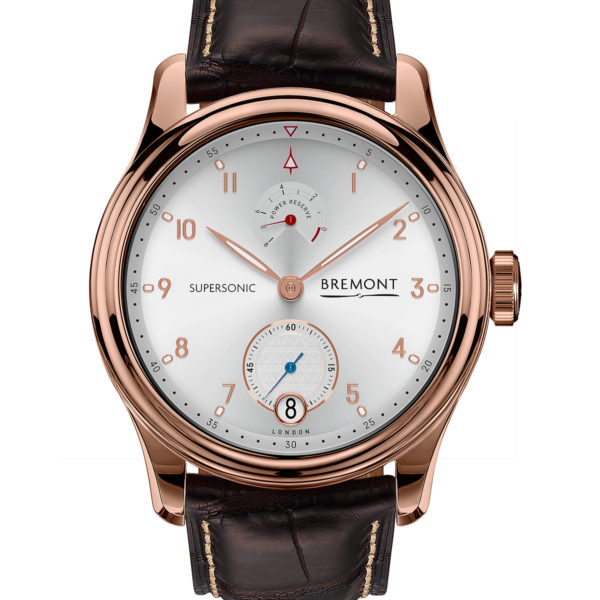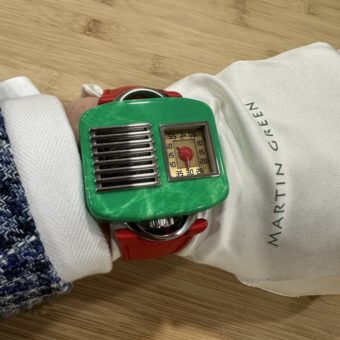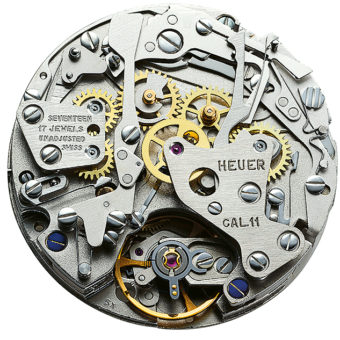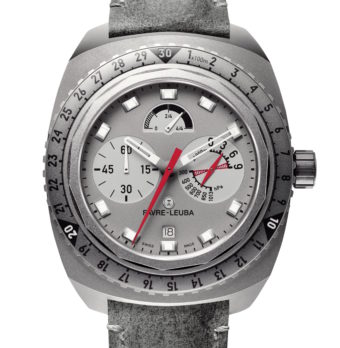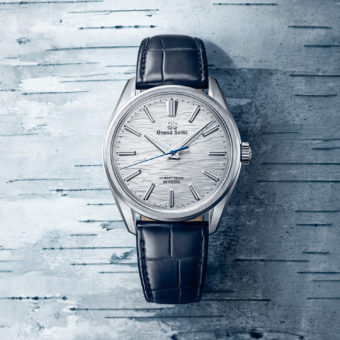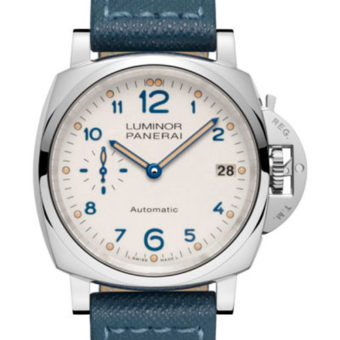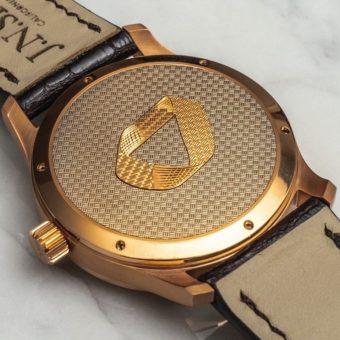One of the reasons WatchTime New York has evolved into the most important and largest luxury watch show in the United States is due to the fact that a number of the fantastic brands attending the show each year chose the weekend as the official launch point for their new timepieces in the United States. This year, we had a number of brands either release new models just in time for the show or use the show as the first opportunity for American-based collectors to see the watches on their own turf. While there were a handful of watches that brands showcased that haven’t been released yet (you’ll see them soon enough), we’re focusing on the watches that had already been announced but hadn’t been seen by the public quite yet.
Akrivia:
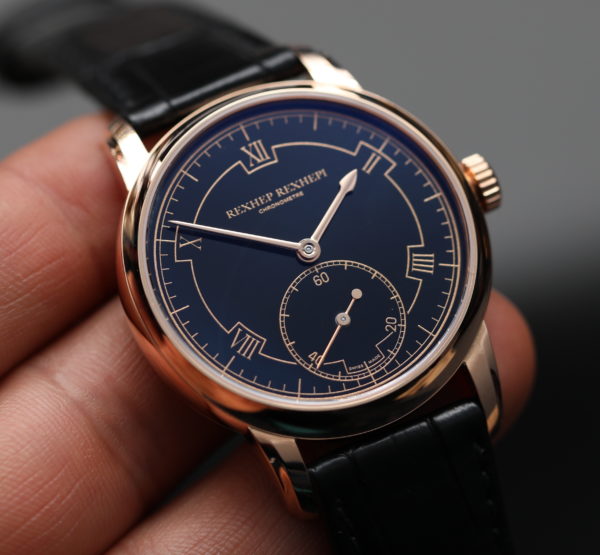
The Akrivia Chronomètre Contemporain is a watch that many industry pundits have described as the most impressive timepiece of 2018 and is an early favorite for this year’s GPHG award in the Men’s category. It’s the brand’s seventh timepiece and the first that is signed with founder Rexhep Rexhepi’s signature. More importantly, it represents a new chapter for the brand as it continues to pivot towards unexplored territory in the horological mainstream. With the Chronomètre Contemporain, Rexhepi wanted to create a contemporary wristwatch interpretation of an old-school marine chronometer. He then combined this desire with his love for the refined lugs and rounded shapes of officers’ watches from the 1940s and ’50s. For the first time in a wristwatch from Akrivia, the watch features no exposed elements on its white or black grand feu enamel dial. It also shrinks the case dimension down to 38 mm compared to the 41-mm and above width seen in previous Akrivia timepieces. A hacking second/zero-reset function carries over from last year’s AK-06, but otherwise, this watch is purely focused on a traditional representation of time. Visible through the exhibition caseback is the manufacture Caliber RR-01 that features an eye-catching blend of anglage, perlage, black polish, côtes de Genève, hand graining, and hand engraving. There’s a play between symmetry and asymmetry through the totally parallel bridge design on the movement and the opposing jut of the Art Deco-inspired lines that frame the Roman numerals on the dial. The decision to sign the Chronomètre Contemporain with Rexhepi’s signature than with the Akrivia handle was reached to signify a new vanguard for the Akrivia label as a whole. “The Akrivia atelier is the basis of all watches produced, whether under the Akrivia name or the Rexhep Rexhepi signed pieces,” Rexhepi says. “The movement inside the Chronomètre Contemporain is meant to be the first chapter of a new product line with a more classical aesthetic, and movements focusing on the traditional essence of watchmaking. This separation of lines is a natural process because I want to be clear in our product imagery, and at the same time, I do not want to be constrained to only the production of classically inspired timepieces – or only a modern aesthetic. I need to have the freedom for both points of view, also because I have so many years to go in defining Akrivia’s future development.”
Lang & Heyne:
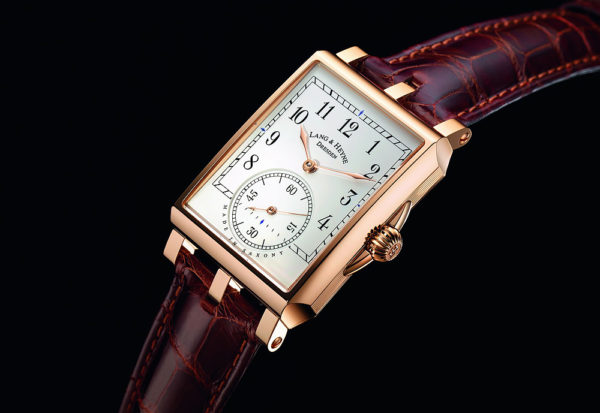
Like all timepieces made by Lang & Heyne, this watch is named for a historical ruler of Saxony, which is now known to watch aficionados as the hotbed of German haute horlogerie. This model’s namesake is George, Duke of Saxony, known as “George the Bearded” (1471-1539). Its sharply angled curved rectangular case, offered in either rose gold or platinum, measures 40 mm by 32 mm in diameter and a svelte 9.4 mm thick, with sapphire crystals over the top and bottom, and is held to the alligator leather strap by distinctive, curved triple lugs. The watch’s sunken enamel dial is accented with black, blue-accented, Art Deco-style Arabic numerals for the hours, which are swept over by golden hands, and notable for its small-seconds subdial, whose unusually large diameter of 14.5 mm lends extra prominence to the passing of the seconds. Inside the case and on full display behind the caseback crystal is the manual-winding Caliber VIII, with golden wheels, lever, and springs; stainless steel bridges and cocks with domed tops and polished stone countersinks; and a combination of matte and polished surfaces throughout. The movement, which is equipped with a stop-seconds function, includes 20 total jewels (19 rubies and 1 diamond), beats at a frequency of 18,000 vph, and stores a power reserve of 55 hours. The rose-gold version of the Lang & Heyne Model Georg Caliber VIII (pictured above) comes on a burgundy alligator leather strap, while the platinum version (below) comes on blue alligator leather. Both straps have a sharkskin inner lining and both can be customized with either a pin buckle or a folding clasp.
Raymond Weil:
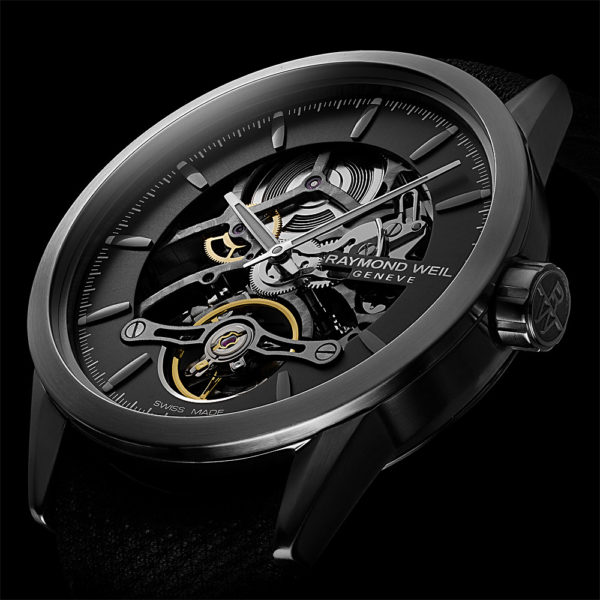
Raymond Weil introduced Calibre RW1212, the family-owned Swiss brand’s first in-house-developed movement, inside a classical two-handed watch in its flagship Freelancer collection in 2017, and unveiled three timepieces containing the next evolution of that movement, with its skeletonized plates and bridges and wide openworked dial, one year later, at Baselworld 2o18. The latest iteration stands out with both its new titanium-PVD case finish (previous options were traditional stainless steel, steel with black PVD, and two-tone steel and rose-gold-plated PVD) and the eye-catching anthracite NAC treatment that has been applied to the openworked baseplate. Like previous RW1212 models, both skeletonized and non-skeletonized, the watch has a 42-mm round case and is equipped with Calibre RW1212, named for the postal code (1212) of Raymond Weil’s headquarters in the Geneva suburb of Grand-Lancy. Produced in a collaboration between Raymond Weil’s R&D department and the designers at Swiss movement specialists Sellita, this movement’s signature feature is its dial-side regulating organ, whose balance-and-spring construction, positioned above the mainplate and held by two bridges, draws the eye at 6 o’clock and resembles a tourbillon. The skeletonization of the movement parts offer an unobstructed view of not only that telltale front-mounted balance but much of the rest of the mechanism as well. This latest iteration of Raymond Weil’s proprietary, self-winding movement powers a no-frills hour-and-minute time display on two barrel-shaped hands, which indicate the time on an hours-and-minutes ring treated with a galvanic anthracite coating; beats at a frequency of 28,800 vph; and carries a power reserve of 38 hours. The oscillating weight has been skeletonized to add additional interest to the rear side of the movement, which is on display through a sapphire caseback. The watch is delivered on a black polyurethane strap equipped with a satin-brushed, stainless steel folding clasp with a titanium PVD coating and a double-push security system. Click here for more details.
Grand Seiko:
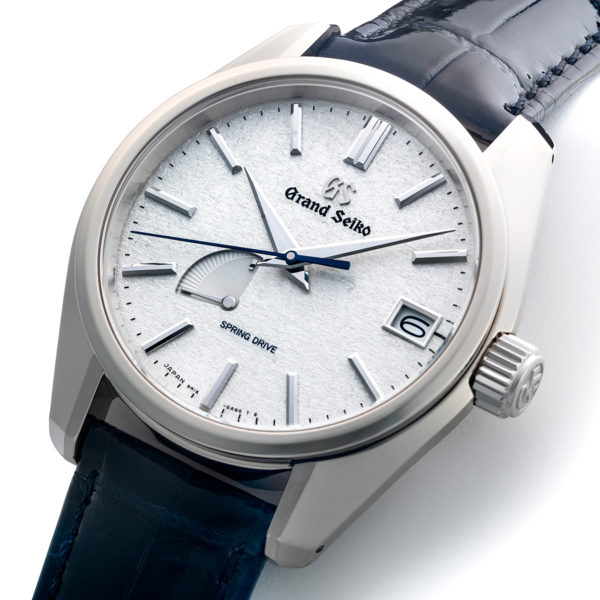
The first Grand Seiko arrived in 1960 and was all but unknown at the time to watch enthusiasts in the United States. How times have changed: this year, the Japanese high-end watchmaker, now independent of the Seiko parent company, has launched its first limited-edition timepiece to be sold exclusively in the U.S. market. The lustrous, shimmering dials of the Limited Editions (cased in 950 platinum, 18k rose gold, or stainless steel) are enlivened by a traditional Japanese painting technique called Kira-zuri (which translates to “sparkling painting”), used to create the textured backgrounds behind actors in Kabuki theater performances. Each of the three dials is subtly different: an additional plating process has been used on the dial of the platinum model (above) for increased clarity and depth, for example, while the dial of the stainless steel version (below) dazzles with a blue tone that is inspired, Grand Seiko says, by “the clear blue skies over the Sea of Japan.” Inside the watches’ 40-mm-diameter cases, with their dual-curved sapphire crystals and Zaratsu-finished, polished surfaces, beats the Grand Seiko Spring Drive 9R15/65 movement, with 30 jewels and a 72-hour power reserve. Invented by Seiko, Spring Drive calibers achieve their high level of timekeeping accuracy (+/- 0.5 seconds per day, +/- 10 seconds per month) through their use of a balance wheel, electromagnetic energy, and a quartz oscillator instead of a traditional escapement. This “Tri-Synchro Regulator” transmits energy to a classical rotor, which is visible, along with other movement parts, through a clear sapphire caseback. The classically elegant dials host a date window at 3 o’clock and a fan-shaped power reserve indicator between 7 and 8 o’clock. The cases are water-resistant to 100 meters and magnetic-resistant to 4,800 A/m. The platinum and rose-gold versions of the watch are mounted on crocodile straps with three-fold, push-button clasps, while the steel model comes on a stainless steel bracelet with additional croc straps (one brown, one black) included. The platinum watch, a limited edition of only 20 pieces, is priced at $53,000. The rose-gold model, limited to 50 pieces, retails for $29,500. The stainless steel timepiece, limited to a slightly more accessible 558 pieces, is priced at $6,800.
RGM:
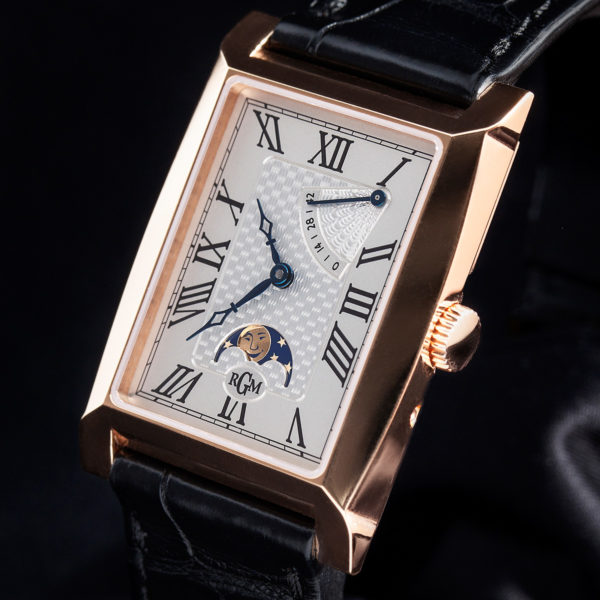
Bremont:
Bremont, the proudly British watch manufacturer that since its founding in 2002 has paid tribute to numerous icons in the United Kingdom’s illustrious aviation history, introduced its latest historically inspired timepiece today: the Bremont Supersonic, a limited edition commemorating the 50th anniversary of the famous Concorde and featuring the brand’s first manual-winding, eight-day movement. British Airways — which, along with Air France, was one of only two airlines to fly the Concorde, a turbojet-powered supersonic passenger airliner, during its heyday from 1976 to 2003 — becomes the latest British heritage organization to partner with Bremont for the launch of a historically significant timepiece, following in the footsteps of Jaguar automobiles, cockpit ejection seat maker Martin-Baker, and others. The watch itself, which incorporates aluminum from a 1970s Concorde plane into its case, becomes the latest in Bremont’s series of special editions enhanced with antique materials representing significant events and institutions in British history, following up such milestone pieces as the 2013’s Codebreaker and last year’s 1918 Limited Edition. For those not as well versed in aviation history as Bremont’s founders (and avid pilots) Nick and Giles English, the Concorde was renowned for its speed of Mach 2.04, twice the speed of sound, which enabled airlines to halve the time of transatlantic crossings. The G-BOAB Concorde “Alpha Bravo,” the third to join British Airways’ fleet, is the model from which Bremont received the metal to enhance all three versions of the Supersonic, in steel, white gold, and rose gold. The watch’s case, constructed in Bremont’s modular “Trip-Tick” style, measures 43 mm in diameter and 14.56 mm thick. Each case features a decorated inner ring within the exhibition caseback, underneath the sapphire glass, machined from aluminum taken from the Concorde. Adorning each of these rings are vital stats from the aircraft: number and registration, top speed, years of active service, and a number of supersonic flights. Another scratch-resistant, nonreflective sapphire crystal in the front covers the sunray-patterned, silvery white dial, which evokes the Concorde’s specially developed, highly reflective white paint job. The blued hour and minute hands on the stainless steel watch, and the blued small-seconds hand on all the models, reflect the British Airways blue on the Concorde’s livery, while a (very) subtle motif of the plane’s silhouette decorates the small seconds subdial at 6 o’clock, which intersects a small, round date window. Another, more prominent instance of the Concorde’s aerodynamic silhouette can be found in the movement, which Bremont has dubbed Caliber BE-11M, a manual winder with a 21,600-vph frequency and, notably, the aforementioned eight-day power reserve, which is on display in a subdial at 12 o’clock on the dial. Visible through the clear caseback and surrounded by the aluminum ring from the G-BOAB Concorde, the movement’s plate is not only enhanced with côtes de Genève but also forms a cutout silhouette of the namesake aircraft. The Bremont Supersonic in stainless steel, with blued steel hands and Connolly leather strap in Concorde blue, is limited to 300 pieces and retails for $12,495. The rose gold model, with rose gold hands and indices and brown crocodile strap, is limited to 100 pieces and is priced at $22,495. The white-gold Supersonic, with nickel hands and a blue croc leather strap, is also limited to 100 pieces and sells for $23,995.

